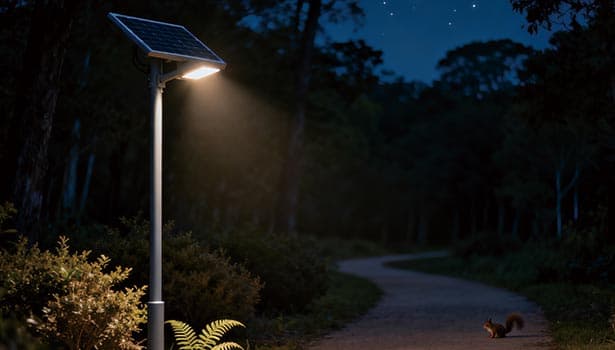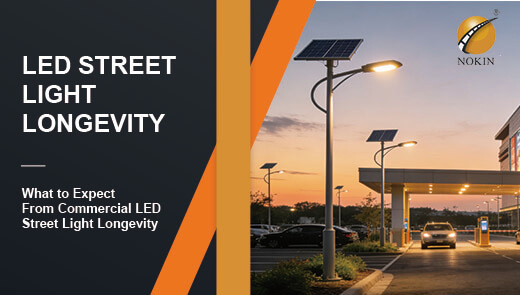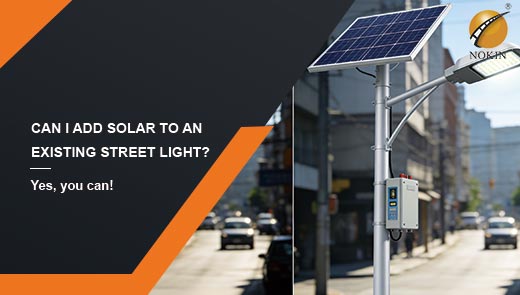Solar Street Light for Natural Areas
The lighting requirements in natural areas are completely different from those in urban areas. It is necessary not only to ensure the safety of tourists and present the characteristics of the landscape, but also to strictly protect the ecological environment at night and avoid disturbing the survival rhythm of organisms. Next, NOKIN will systematically disassemble for you the lighting standards, selection tips, and key points for installation and maintenance of solar street lights in natural areas.

The Impact of Light Pollution on the Ecosystem
Improper night lighting has become an invisible ecological threat to natural areas. Unlike urban environments, the biological communities in natural areas are more sensitive to changes in light. Improper lighting can directly disrupt the circadian rhythms of insects, amphibians, birds and mammals, interfere with their foraging, reproduction and migration behaviors, and even disrupt the pollination chain, causing an imbalance in the ecological chain.
The Guardian of the UK once cited research indicating that light pollution has led to a decline in the population of some insects. As a fundamental link in the ecosystem, the reduction of insects will have a chain reaction impact on the survival of birds and small mammals. For migratory birds, overly bright lights can cause them to lose their way and deviate from their migratory routes. The reproductive behavior of amphibians relies on environmental signals at night. Light interference will directly reduce the success rate of reproduction.
Natural areas are more vulnerable to light pollution than streets and urban areas. The core reason lies in their higher ecological fragility and the denser distribution of biological migration paths and breeding scenarios. The principle of "bright, even and wide" in urban lighting is completely inapplicable to natural areas, and there is an urgent need for targeted eco-friendly lighting solutions.
The Advantages of Solar Street Lights in Natural Areas
Solar street lights, with their unique advantages, have become the preferred solution for lighting in natural areas. They not only address the pain points of traditional lighting but also meet the demands of ecological protection. Solar street lights have a wide range of applications in natural areas, including park walkways, viewing platforms, outer areas of tourist centers, plank roads, waterfront areas, entrances to protected areas and patrol paths, etc. These scenarios are mostly far from the coverage of the power grid and have strict restrictions on ecological interference, allowing the advantages of solar street lights to be fully exploited.
Off-grid Installation, Reducing Ecological Disturbance
The installation of solar street lights does not require the laying of cables, avoiding the need to dig the ground to damage vegetation and disturb the soil. It is especially suitable for sensitive areas such as nature reserves and waterfront areas with complex terrain.
Low Cost Throughout the Entire Life Cycle
There is no need to invest in cable laying costs during the construction stage, zero electricity charges during the operation stage, and the maintenance frequency is low. The long-term usage cost is much lower than that of traditional power grid lighting. The average initial investment for solar street light projects in natural areas can be recovered within 3 to 5 years.
Adapt to Ecological Control Strategies
It can be flexibly combined with functions such as motion sensing, zone control, and intelligent dimming to achieve "lights on when people come and off when they leave" or dimming at night. This not only reduces energy waste but also minimizes the interference of continuous lighting at night on living things.
Eco-friendly Solar Street Light Lighting Design
Spectrum and Color Temperature
The spectrum and color temperature of light directly determine the degree of impact on the ecosystem, and the composition of blue light and the range of color temperature must be strictly controlled.
It is recommended to give priority to low color temperature light sources, with a color temperature of no more than 3000K, and the optimal range is 2200-2700K. This type of light source has a low blue light component, soft light and weak scattering, which can significantly reduce the pollution of sky lighting and minimize the stimulation to the visual system of nocturnal animals. Studies show that warm light sources below 2700K cause more than 60% less disturbance to insects and amphibians than white light sources above 4000K.
Light Intensity and Illuminance
Natural area lighting does not need to pursue high brightness. It is necessary to strike a balance between "safe visibility" and "ecological protection", and avoid excessive lighting.
It is recommended that the average illuminance be controlled within the range of 5 to 8 lux. The specific range can be adjusted according to the scene: the upper limit of 8 lux should be set for core areas such as walkways and patrol paths, while the lower limit of 5 lux should be set for non-essential lighting areas such as viewing platforms and waterfront areas. During the late-night hours, the illuminance can be reduced to 2 to 3 lux through intelligent control, ensuring basic safety without affecting biological activities.
The appropriate low-light design of solar street lights not only protects the ecology but also enhances the visibility of the night sky, providing tourists with a better starry sky observation experience and aligning with the landscape positioning of natural areas.
Beam Control
The random overflow of light beams is one of the main sources of light pollution. It is necessary to reduce light waste and ecological disturbance through precise light beam control.
The core measure is to adopt fully light-blocking lights. Such lights can completely block the upward and lateral light overflow, and only project the light directionally to the ground demand area, avoiding the sky light being illuminated. The Toronto Municipal government's natural park lighting regulations clearly stipulate that all outdoor lights must adopt a fully light-blocking design to protect the night ecological environment around the city.
In addition, the appropriate light distribution curve should be selected based on the scene requirements. For instance, narrow beam Angle lights should be used for walkway lighting to prevent light from spreading to the surrounding vegetation areas.
Dynamic Control Strategy
Dynamic control is a key means to achieve "energy conservation + ecological protection", by flexibly adjusting the lighting state to meet the demands of different time periods.
The first is motion sensing control. The light defaults to low brightness standby. When it detects human activity, it automatically increases the brightness. After the person leaves, it returns to low brightness.
The second is to implement zoned and time-slot lighting. According to the activity patterns of tourists, the lighting fixtures in non-core areas should be reduced to the minimum safe brightness during the late night (such as from 23:00 to 5:00 the next day).
The third is intelligent dimming and timer, which adjusts the lighting period and brightness in combination with seasonal changes and the number of tourists. For example, the lighting time is shortened in winter and appropriately extended in summer.

How to Select Solar Street Light Systems for Natural Areas?
The environmental conditions in natural areas are complex. The selection of solar energy systems needs to take into account stability, durability and ecological compatibility. The following are the core engineering points:
Photovoltaic Module
The selection of photovoltaic modules directly determines the stability of power supply and needs to be precisely designed in combination with the on-site sunlight conditions.
Monocrystalline silicon photovoltaic panels should be given priority. They have a high conversion efficiency (the current mainstream efficiency is 22% - 24%), occupy a small area, and are suitable for the landscape integration needs of natural areas.
Before installation, on-site sunlight assessment is required. The inclination and orientation of the photovoltaic panels should be determined based on latitude, terrain, and vegetation shading conditions. In the Northern Hemisphere, south-facing installation is preferred, with an inclination recommended to be ±5° of the local latitude to maximize the reception of solar radiation.
For areas with dense vegetation and short daylight hours, the power of photovoltaic panels can be appropriately increased, with a power margin of 15% to 20% reserved to ensure the power supply stability of solar street lights during rainy and cloudy weather.
Energy Storage System
Energy storage batteries are the core components of solar street lights and need to take into account capacity, lifespan and maintenance costs.
The battery type is recommended to use lithium iron phosphate (LiFePO4) batteries. They have a long cycle life, stable charge and discharge performance, good low-temperature tolerance, and low maintenance requirements, making them suitable for long-term unattended scenarios in natural areas.
The capacity design should be calculated based on the power of the solar street light, the duration of lighting, and the number of rainy days. It is recommended to reserve a capacity margin of more than 30%, and control the depth of discharge within 80% to extend the battery life.
The Height and Spacing of Light Poles
The height and spacing of the light poles of solar street lights should be comprehensively designed in combination with the scene requirements, light distribution curves and terrain conditions to avoid excessive lighting or blind spots in lighting.
The height of the light poles for the walkway lighting is recommended to be 3 to 5 meters. For viewing platforms and open areas, it can be raised to 5 to 7 meters. The spacing should be determined based on the photometric curve of the lights, generally 3 to 5 times the height of the light post. For example, for a 5-meter-high light pole, the spacing should be controlled at 15 to 25 meters.
Before installation, on-site optical simulation or illuminance calculation should be conducted. The position of the light pole should be adjusted in accordance with the terrain undulations and vegetation occlusion conditions to ensure uniform ground illuminance without obvious bright spots or dark areas. The material of the light pole should preferably be aluminum alloy or stainless steel, which is not only lightweight and corrosion-resistant, but also has a simple appearance and is easy to blend with the natural landscape.
Wind-resistant, Impact-resistant and Waterproof Design
There are many climate and environmental challenges in natural areas, so the lighting fixtures and systems need to have high-intensity protection capabilities.
In terms of wind resistance design, the appropriate wind resistance level should be selected based on the local maximum wind speed. Generally, the wind resistance should be ≥ level 12. The bottom of the light post needs to be reinforced to prevent it from toppling over. Equipment in coastal and salt spray areas should be made of anti-corrosion materials, and the surface should be treated with fluorocarbon spraying or hot-dip galvanizing to prevent salt spray erosion. Anti-collision protective covers should be installed on light posts in areas where wild animals are active. The height is recommended to be less than 1.5 meters to prevent damage from collisions by animals such as deer and hares.
In terms of waterproof grade, the protection grade of the light housing should reach IP65 or above, and the protection grade of the photovoltaic module and battery box should not be lower than IP67 to ensure stable operation in rainy and humid environments.
Environmental Impact Assessment and Approval for Solar Street Lights in Natural Areas
When deploying solar street lights in natural areas, it is necessary to strictly follow the environmental impact assessment and approval procedures to avoid the risk of ecological damage.
Nighttime Ecological Impact Assessment
Before construction, entrust a professional agency to conduct an assessment to clarify the types of sensitive organisms, their activity periods and habitat distribution within the project area, and determine the safe range and restrictive conditions for lighting.
Stakeholder Communication
Communicate with stakeholders such as environmental protection organizations, local communities, and forestry departments, solicit opinions on the lighting plan, and optimize design details.
Construction Period Restrictions
Avoid construction during sensitive periods such as the breeding and migration seasons of organisms, for instance, during the bird migration season and the breeding season of amphibians, to minimize disturbance to the organisms.

FAQ About Solar Street Lights in Natural Areas
Q1: Will Solar Street Lights in Natural Areas Harm Nocturnal Animals?
No, as long as scientific design is adopted, the impact can be significantly reduced. By choosing lights with low color temperature (≤3000K) and full shading distribution, and controlling the illuminance at 5-8 lux, and combining them with dynamic control strategies such as motion sensing and late-night brightness reduction, the interference of light on nocturnal animals can be reduced. Such a design can reduce the ecological impact by more than 80%.
Q2: Can Solar Street Lights Provide Stable Power Supply in Rainy and Cloudy Areas?
It can provide stable power supply. This can be achieved by rationally designing the power of photovoltaic modules and the capacity of batteries. It is recommended to reserve a power margin of 15% to 20% for photovoltaic power, use lithium iron phosphate batteries and reserve a capacity margin of more than 30% to ensure that the solar street lights can still work normally in continuous 7 to 10 days of rainy weather.
Q3: What are DarkSky Friendly Lights?
DarkSky friendly lighting fixtures are eco-lighting products certified by the International Dark-Sky Association (IDA). The core requirements include: color temperature ≤3000K, full shading design, no upward light overflow, and controllable light intensity. They meet the ecological protection needs of natural areas at night and are the preferred type of lighting fixtures for natural areas.
Deploying solar street lights in natural areas is by no means a simple "installation of lighting tools", but a systematic project with ecological protection at its core. It not only can achieve the practical value of off-grid power supply and cost reduction, but also can balance the three major demands of "safety, landscape and ecology" through scientific spectral design, beam control and dynamic strategies.
By following the design guidelines and practical operation points of this article, choosing DarkSky friendly lights and strictly adhering to the environmental impact assessment process, solar street lights can become the "ecological guardians" of natural areas, providing tourists with a safe and comfortable lighting experience while safeguarding the authenticity of the night ecology.




